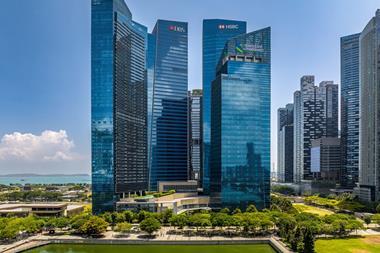Bullishness about Asia sits alongside concern about the region's ability to absorb and retain capital. So select your opportunities carefully, warns Michael Grimes
Asia Pacific property investment markets have - in theory - the same repertoire of securities instruments available to them as are found in Europe and North America. In Asia, though, cash - mainly in the form of private equity - is king.
In China, relatively cash-poor local developers can choose from a range of cash-rich suitors looking to participate in a high-growth market. The suitors include European and North American institutions, state investment companies from within the region and Arabian Gulf states with oil revenues looking for new destinations since the US Patriot Act made investment in the US more problematic.
In the short term, a general preference among Asians for cash might be a blessing in the wake of the storm caused by bad paper in the US sub-prime mortgage industry. Media reports suggest that Indian banks' combined losses in that market amount to $2bn. So far there have been no confirmed reports of major losses in the Chinese banking sector.
The lack of sophisticated capital markets - particularly in China - could have a long-term negative effect on investments around the Pacific Rim. With so much local liquidity and so many foreign investors seeking exposure to China and its neighbouring economies, the danger is that asset prices will be forced ever higher and yields reduced until the various bubbles burst, sparking an outflow of capital of the sort seen in the Asian financial crash of 1997.
The International Monetary Fund (IMF) estimates the region's foreign exchange reserves will exceed $1.8trn (€1.3trn) this year. China had already accumulated $1.3trn of that by June and is straining to find ways of mopping up this liquidity. According to a recent note from Morgan Stanley economist Stephen Roach, the huge reserves pushed up broad money supply in the region by some 17% in 2006, or nearly three times the rate of growth in developed economies.
The development of more sophisticated capital markets in Asia, with a greater range and utilisation of secondary products, may be the best way of mopping up this liquidity and maintaining long-term stability in asset values.
The challenge is that with cheap debt and even cheaper equity, there is no incentive yet for existing investors to dilute their exposure - especially at a time when some Asia Pacific property markets are still registering double-digit yields.
Some Europeans do, however, see signs of growing sophistication in Asian capital markets.
"We are seeing an increasing variety of investment products in Asia as well as the opportunity for risk diversification for European investors, so we think the Asian market is a place to be," says Marc Weinstock, a board member at HSH Real Estate, a unit of HSH Nordbank of Germany.
HSH and Pacific Star Group, a Singapore-based real estate investment and fund management company, have jointly set up a fund to invest in prime properties in Asia. The partners aim to raise €500m. Once the first is fully subscribed, they intend to open more funds.
"We think that in the foreseeable future, selected Asian markets will provide better perspective for real estate investors than other regions," adds Weinstock.
"Long-term economic growth, positive demographic trends and market size should work as a sound basis for the further expansion of individual markets across various asset classes."
The key words in Weinstock's comments are ‘selected Asian markets'. Asia Pacific is not homogenous, either culturally, politically or financially. Despite the relatively low yields offered by Australian real estate, a large number of foreign institutions are showing an interest in the country, attracted by the quality of its property product and the sophistication and stability of its financial markets. When Australia's Investa Property Group delisted and recently put 13 city office properties up for sale, with a total valuation of A$1bn (€621m), it received enquiries from Europe and other parts of Asia. Investa itself was sold to US-based Morgan Stanley Real Estate for a reported A$4.7bn in May.
The 13 Investa properties up for disposal include seven in Melbourne, two in Sydney, two in Brisbane, one in Perth and one in Canberra.
John Marasco, managing director of investment sales for Colliers International in Australia, says: "We expect this sale will really set a new benchmark in values - especially for the Melbourne properties, where this year we haven't seen a lot of sale activity. We expect there to be strong competition for the properties."
Weinstock's earlier reference to the increasing variety of investment products in Asian real estate is likely to be the key to the region's long-term success.
An insight on regional attitudes toward real estate securities is revealed in ‘Emerging Trends in Real Estate Asia Pacific 2008', a recent report by the Washington DC-based research body Urban Land Institute and the professional services firm PricewaterhouseCoopers.
The study conducted a poll among Asia Pacific property experts about the investment prospects for different asset classes across global real estate markets. The 155 respondents - including representatives from investors, developers and lenders - put private direct investment in Asia top, and US commercial mortgage-backed securities (CMBS) at the bottom.
While this is hardly surprising given the recent difficulties of the US mortgage market, it is worth noting that although debt of all kinds is still relatively cheap in Asia Pacific, the respondents ranked the prospects of Asia Pacific investment grade bonds below European private direct investment and European publicly listed property companies and European real estate investment trusts (REITs), despite ranking the general growth prospects of Europe below those of Asia Pacific.
In China, the range of real estate asset classes is generally small. Using growth to leverage the project finance and getting rent increases to provide income is typically as sophisticated as it gets.
Despite the threats of further yield compression as more money enters the market, Asia Pacific is so big there are still opportunities in secondary markets away from the main cities, though the risk curve tends to rise as the investor gets further away from those established markets.
But there are clear signs that, taken as a whole, the Asia Pacific market is moving
toward maturity. About 50% of the increased transaction volume in the region in 2006 was actually caused by yield compression, says Guy Hollis, country head for China at Jones Lang LaSalle, the real estate services and investment consultant.
David Watt, of DTZ, the London-based global real estate advisers, says yield compression in Asia Pacific real estate amounted to an average of 100 bps in 2006, about twice that seen in the US. At the same time the amount of cross-border capital going in to Asia Pacific property has also risen from 29% of the total in 2005, to 32% of the total last year, says Hollis.
It cannot be assumed, however, that such large capital inflows will be maintained indefinitely. In a market where a lot of capital is chasing a limited amount of product, and the capital efficiency of the primary investors is falling, the development of a secondary securities market may be the only way for competing investors to maintain a position in Asian real estate. Without a secondary market, the only alternative may be for some investors to pull out completely and focus on more opportunistic projects. The ‘yen carry trade' is a good example of deep capital markets adding value to an economy. Foreign institutions buy yen loans taking advantage of Japan's low interest rates, then unwind them to invest in higher-yielding assets elsewhere.
Japan and other mature markets such as Australia, Singapore and Hong Kong are the first jurisdictions to develop a wide range of real estate asset classes, including the provision of REITs.
As of July 2007, a total of 107 REITs raising equity either through IPOs or secondary securities were listed in seven countries across the Asia Pacific region and had a combined value of $185.6bn. This is a modest proportion of total asset values when compared with global figures for REIT asset holdings of $655.1bn.
REITs are not yet a hit in Asia Pacific. Some analysts attribute this to the fact the markets with most exposure to REITs currently offer more capital efficient ways of gaining investment exposure there. The long-term prospects for REITs look stronger. Future rent increases should eventually provide them with earnings similar to those of private equity players. The biggest current markets for REITs are in Japan (there are 41 listed with a combined value of $46.6bn) and Australia, where the real estate investment market is supported by the country's compulsory superannuation retirement fund scheme for all employees. In Japan, investors are used to low yields (10-year government bonds yield about 1.9%), so the 2.94% average weighted yield of a JREIT available as at June 2007 looks like good value.
Most debt-based real estate deals in Asia Pacific are raised from banks and there remains little demand for securitised financing, such as CMBS and collateralised debt obligations (CDOs). The latter products have not yet been seen in Asia Pacific.
The main CMBS markets are Australia and Japan. In Australia, the CMBS has become a major financing option for real estate investors, driven largely by the country's listed property trusts (the local REIT market). Issues exceeded $972m in 2007, according to Commercial Mortgage Alert. Japan continues to be the largest regional player in the CMBS market, representing over 65% of all transactions in 2007 totalling $3.86bn. Otherwise, the biggest regional player is Singapore, which has produced 15 CMBS transactions since 2002, though issues have reduced significantly this year. A few CMBS issues have also been seen in Hong Kong, Taiwan, and Malaysia. China launched its first two CMBS notes last year.
The slow growth of CMBS partly reflects a cultural reluctance among Asian people to borrow, and this has seeped into financing practices. The fact though that the cost of equity is currently lower than the cost of debt is, historically speaking, an anomaly.
Mezzanine finance has proved popular with public companies in Asia Pacific's soaring equities market. Although it is more expensive than asset-secured debt it offers the flexibility of raising debt secured against company equity without excessively diluting the existing stockholders' stakes. Mezzanine deals have been favoured as an element in offshore financing packages for property in China. They provide investors with tax breaks, access to cheaper capital, and a free ride on China's slowly appreciating currency. Recently, however, Beijing has introduced new regulations (following similar moves by the Indian authorities), which seek to end the financing of mainland property investments with offshore loans. Whether these regulations can be enforced remains to
be seen.
Index-linked property derivatives, which were launched in the UK at the end of 2005, might prove popular in Asia. They allow investors (and speculators) to make over-the-counter bets against movements of a benchmark index over a set time frame.
Trading of residential derivatives was launched in Hong Kong in February this year, followed by tests of commercial property derivatives (based on indices compiled by Investment Property Databank) in Australia and Japan.
In general, the main concern among market players seems to be unease over the return of inflation and rising global interest rates.
"What concerns me is what happens to real estate market cap rates as alternative benchmark rates - the bond rates in these countries - are rising," one analyst told the Emerging Trends in Real Estate Asia Pacific 2008 report. "In that context, I worry about ultra-low yields that we see at present due to the weight of capital in the direct markets. The risk is that Asia gets caught by a developed-world squeeze in which capital markets in North America or Europe move against real estate. A withdrawal in capital from emerging markets is typically more volatile than in the developed world.
"As we saw in 1997, what comes in can go out, and if things go pear-shaped and people become jittery I could see quite a lot of the capital run for cover. They all say they're long term, but that's something the more serious of us ponder."












